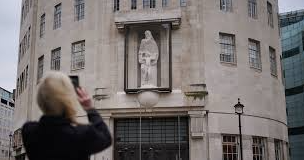
Restoration of sculpture by disgraced artist reignites debate over separating art from the actions of its creator
The BBC has reinstalled a sculpture by Eric Gill outside Broadcasting House, placing it behind a protective screen and adding a QR code to inform the public about the troubling past of its creator.
The statue, which shows Shakespeare’s Prospero and Ariel, was damaged in 2022 by a protester wielding a hammer. It had remained largely hidden from public view ever since. The restoration was carried out with guidance from heritage experts, with the BBC emphasising it does not condone Gill’s abusive history.
Eric Gill, once celebrated as one of Britain’s foremost sculptors of the early 20th century, became the subject of significant controversy decades after his death when his personal diaries were published. They revealed that Gill had sexually abused his daughters and engaged in disturbing sexual behaviour involving the family dog.
Despite his artistic reputation, these revelations sparked widespread calls for his work to be removed from public spaces, particularly from Broadcasting House, where the sculpture has stood since being carved on-site in the early 1930s. The statue has also drawn attention from far-right figures and conspiracy groups, intensifying the controversy.
A BBC spokesperson explained: “Broadcasting House is nearly a century old and is a building of both historical and cultural importance. The Ariel and Prospero sculpture is considered an integral architectural element of the site. While the BBC strongly rejects Gill’s reprehensible actions, we have taken a view—following expert advice—that the artwork and its creator should be seen separately.”
They noted that after the sculpture was seriously damaged on two separate occasions, all repair efforts had to comply with the building’s Grade II* listing. In coordination with Westminster City Council and Historic England, a transparent screen has been installed to deter future acts of vandalism.
The restoration and protective works cost just over £500,000. To promote public awareness, a QR code positioned near the sculpture links to information about both its artistic context and the disturbing personal history of its sculptor.
Duncan Wilson, chief executive of Historic England, supported the BBC’s decision. “Since the revelations about Gill’s abuse became public in the late 1980s, his legacy has understandably become highly contested,” he said. “We support the BBC’s effort to preserve the historic building while also acknowledging the complexities surrounding this piece of art.”
The decision has reignited debate around whether controversial art can or should be preserved when its creator’s actions are indefensible. The BBC maintains that it has approached the issue responsibly, balancing historical integrity with ethical responsibility and public transparency.









